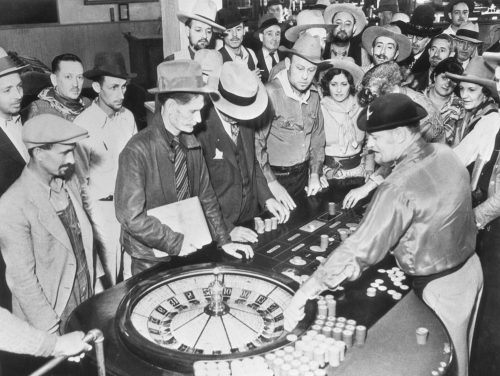
Las Vegas, often dubbed as the entertainment capital of the world, has a rich history that began with humble beginnings and has transformed into a dazzling metropolis of modern casinos. This comprehensive look into the evolution of Las Vegas casinos highlights the contrasts between the first establishments and today’s cutting-edge resorts, offering a detailed examination of how they have shaped the city’s identity.
Early Beginnings: The First Casinos in Las Vegas
1. El Rancho Vegas (1941) The first significant casino on what would become the iconic Las Vegas Strip was El Rancho Vegas, opened in 1941. It featured a western-themed design and offered 63 hotel rooms. Unlike modern resorts, El Rancho focused on providing a cozy, intimate atmosphere with a small casino floor, a pool, and a few dining options. The emphasis was on personal service and creating a relaxed environment for guests.
2. The Flamingo (1946) The Flamingo, opened by the infamous Bugsy Siegel in 1946, marked a turning point in Las Vegas history. It introduced a more glamorous and luxurious concept compared to its predecessors. With 105 rooms and an upscale ambiance, the Flamingo offered high-end entertainment and fine dining, setting a new standard for future casinos.
3. The Golden Nugget (1946) Located in downtown Las Vegas, the Golden Nugget opened in the same year as the Flamingo. It was one of the first major casinos on Fremont Street, featuring a lavish design and focusing on providing a top-tier gambling experience. The Golden Nugget played a significant role in establishing Fremont Street as a vibrant casino hub.
The Transformation: Modern Las Vegas Casinos
1. The Bellagio (1998) The Bellagio represents the epitome of modern luxury in Las Vegas. Opened in 1998, it features a breathtaking design inspired by Lake Como in Italy. With over 3,900 rooms, an 8-acre lake with the famous Fountains of Bellagio, high-end shopping, world-class dining, and an extensive casino floor, the Bellagio offers an all-encompassing experience that goes beyond gambling. It is known for its opulence and sophistication, attracting high rollers and celebrities alike.
2. The Venetian and Palazzo (1999, 2007) The Venetian and its sister property, Palazzo, epitomize the grandeur of modern casinos. The Venetian, opened in 1999, replicates the charm of Venice with its canals, gondola rides, and intricate architecture. Palazzo, added in 2007, enhances the luxury experience with spacious suites and exclusive amenities. Together, they offer an immense casino floor, high-end retail, and some of the finest dining options in the city.
3. The Cosmopolitan (2010) The Cosmopolitan, which opened in 2010, brought a new level of modern chic to the Las Vegas Strip. Known for its contemporary design, it features over 3,000 rooms, an eclectic mix of dining options, vibrant nightlife, and a unique casino experience. The Cosmopolitan’s emphasis on art, design, and innovative entertainment options sets it apart from traditional casinos.
Key Differences Between Early and Modern Casinos
1. Size and Scale Early casinos like El Rancho Vegas and the Flamingo were relatively small, focusing on providing a quaint, personal experience. In contrast, modern casinos such as the Bellagio and Venetian are colossal in size, offering thousands of rooms and extensive amenities that cater to millions of visitors annually.
2. Entertainment and Amenities The first casinos primarily offered gambling and basic entertainment. Modern casinos, however, are entertainment hubs featuring world-class shows, concerts, nightclubs, luxury shopping, fine dining, spas, and more. The integration of diverse attractions has made modern casinos destinations in their own right.
3. Design and Architecture Early casinos had simpler designs, often themed to attract specific audiences. Today’s casinos showcase architectural marvels with elaborate themes and cutting-edge designs. Properties like the Bellagio and The Venetian are not just places to gamble but are also celebrated for their aesthetic appeal and immersive environments.
4. Technology and Gaming The gaming experience itself has evolved significantly. Early casinos had basic slot machines and table games. Modern casinos offer a vast array of electronic gaming machines, high-tech slots, and innovative gaming options such as virtual reality experiences. Additionally, advancements in technology have enhanced security, customer service, and overall operational efficiency.
5. Customer Experience Personalized service was the hallmark of early casinos, with a focus on building relationships with patrons. While modern casinos still value customer service, the scale has shifted towards creating a seamless and luxurious experience through technology, loyalty programs, and an abundance of options catering to diverse preferences.
Conclusion
The journey of Las Vegas casinos from their early days to the present highlights a remarkable transformation. The first casinos laid the groundwork for what would become a global phenomenon, characterized by extravagance and innovation. Modern casinos have redefined the gambling experience, incorporating luxury, entertainment, and technology to create a multifaceted destination. This evolution reflects not only the growth of Las Vegas but also its enduring allure as a symbol of excitement and possibility.
As Las Vegas continues to evolve, its casinos will undoubtedly keep pushing the boundaries of what is possible, ensuring that the city remains at the forefront of the entertainment and hospitality industry.








